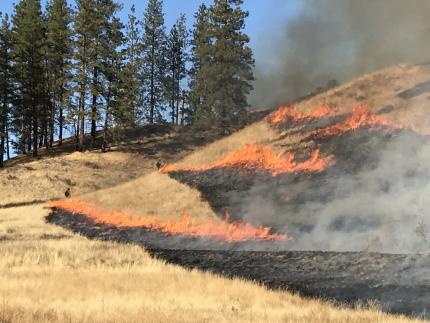ARCHIVED NEWS RELEASE
This document is provided for archival purposes only. Archived documents
do not reflect current WDFW regulations or policy and may contain factual
inaccuracies.
News release Feb. 26, 2020
Matt Eberlein, Prescribed Fire Manager, (509) 429-4236
Staci Lehman, Public Affairs, (509) 710-4511

Annual controlled burns on Washington Department of Fish and Wildlife (WDFW) lands in eastern Washington start in March, as conditions allow. Prescribed fire on WDFW wildlife areas reduces the risk of wildfire, reduces risks to community safety and health, and improves habitat for animals such as deer, elk, and bighorn sheep.
WDFW provides active management for more than one million acres of public lands and operates the state’s only prescribed fire management teams. The teams include four full-time foresters and 18 burn-team members. Their past work with controlled burns can help prevent larger wildfires later.
“It’s not a question of whether we’ll have wildfires on these lands, but rather the degree to which we can reduce the damage they do,” said WDFW Prescribed Fire Manager Matt Eberlein. “By burning off accumulations of vegetation, we can reduce the risk of high-intensity wildfires that destroy wildlife habitat.”
With funding from the state’s 2019-2021 Capital Budget and other grant funds, WDFW intends to treat 10,000 acres by 2021.The work will preserve ecosystems, which helps people to enjoy continued access to Fish and Wildlife public lands.
Restoration fires in the following popular areas begin in the coming month, weather permitting:
- Sherman Creek Wildlife Area, 524 acres in Ferry County, 10 mile west of Kettle Falls
- Rustlers Gulch Wildlife Area, 523 acres in Pend Oreille County, 15 miles southwest of Newport
- Methow Wildlife Area, 248 acres in Okanogan County, 10 miles northeast of Winthrop
- Colockum Wildlife Area, 500 acres in Chelan County, 10 miles southeast of Wenatchee
- Oak Creek Wildlife Area, 120 acres in Yakima County, 15 miles west of Naches
- Grouse Flats Wildlife Area, 400 acres in Asotin County, 40 miles southwest of Clarkston
- L.T. Murray Widllife Area, 250 acres in Kittitas County, 12 miles south of Selah
- Oak Creek Wildlife Area, 226 acres in Yakima and Kittitas counties, 7 miles west of Naches
Additional burns on WDFW eastern Washington lands could be announced as conditions allow.
Public safety is a high priority with any prescribed fire. WDFW staff post signs to inform recreationists, but smoke can still cause visibility issues.
“We work to minimize smoke, but smoke from planned fires can reach populated areas. Please slow down if you experience reduced visibility on roadways, particularly at night or in the early morning,” Eberlein said. “Given that fire personnel and their equipment may be working in the area, it’s just a good idea.”
According to Eberlein, the WDFW burn team also protects public safety by monitoring controlled fires continuously until they are out and past any likelihood of unintentional spread.
By actively managing lands, restoring habitats, and preserving wild places, WDFW serves as steward for Washington’s natural places, protecting the state’s land and water for its human and wildlife populations.
For more on prescribed fire, as well as other information about how WDFW manages for healthy forests, see the WDFW forest management story map, which outlines the projects conducted throughout the state.
The WDFW is the state agency tasked with preserving, protecting and perpetuating fish, wildlife and ecosystems, while providing sustainable fishing, hunting, and other recreation opportunities.